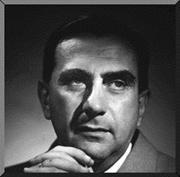 Edward
Teller,
January 15, 1908, Budapest, Hungary, Teller is most famous for his
work on the Manhattan Project that resulted in the first atomic bomb
and the political and personal conflicts that arose in the aftermath
of the use of the A-bomb in Hiroshima and Nagasaki.
Edward
Teller,
January 15, 1908, Budapest, Hungary, Teller is most famous for his
work on the Manhattan Project that resulted in the first atomic bomb
and the political and personal conflicts that arose in the aftermath
of the use of the A-bomb in Hiroshima and Nagasaki.
Teller was born into a wealthy and highly educated Jewish family in Budapest, Hungary. As a child at the end of World War I, he grew up in the volatile world of the newly-independant, Hungarian state that rose out of the collapse of the Austro-Hungarian Empire. At 18, Teller left Budapest to study chemical engineering in Karlsruhe, Germany where he became interested in physics and in particular the new theory of quantum mechanics. Two years later, he transferred to the University of Munich to study physics.
In Munich, he suffered an injury in a streetcar accident that resulted in him losing his right foot. Now walking with a prosthesis, he transferred to the University of Leipzig to study with Werner Heisenberg where he received his doctorate in 1930. After graduation, he worked at the University of Gottingen as a research consultant where he wrote he first published paper: "Hydrogen Molecular Ion." When the anti-Semitic, Nazi party led by Adolph Hitler came to power in Germany, Teller knew that he had to leave and emigrated to Denmark in 1934. In Denmark, he joined a team of young scientists at the Institute of Theoretical Physics working with Niels Bohr. At the institute, Teller met Russian political refugee and physicist George Gamow with whom he would eventually do some of his most notable work.
Teller followed Gamow to the United States of America in 1935 where at George Washington University they formulated the Gamow-Teller rules for classifying subatomic particle behavior in radioactive decay. In 1941, Edward Teller became a naturalized U.S. citizen. His desire to lead a quiet academic life was threatened however by the revelation he shared with several other refugee physicists that a team led by his old teacher Heisenberg had discovered nuclear fission. He feared that the most destructive force in the history of the world would fall into the hands of Nazi Germany.
Appeals from the most notable scientists in the U.S. including Albert Einstein, convinced the Roosevelt administration to assemble a top-secret team to develop an atomic weapon before the Germans. This resulted in the formation of the Manhattan Project under Dr. J. Robert Oppenheimer. Teller joined the project in Chicago where he worked with Enrico Fermi, and Berkeley where he worked with Oppenheimer before heading to the projects secret laboratory in Los Alamos, New Mexico. Fears among some of the scientists on the team that a nuclear explosion might continue indefinitely and consume the earth were allayed by Teller's calculations that the nuclear explosion, while enormously powerful, would only destroy a limited area. In 1945, a successful test of the bomb was carried out in Alamogordo, New Mexico.
While working on the A-bomb, Teller became convinced that using the power of a nuclear fission reaction, nuclear fusion could be accomplished to far more devastating results. To Teller's dismay, this avenue of research was rejected by the Manhattan project leadership. After the war when the Russians demonstrated their own atomic bomb, President Harry Truman, authorized development of the fusion weapon which came to be known as the hydrogen bomb. The first hydrogen bomb was tested at the Eniwetok Atoll in the South Pacific Ocean in 1952.
Many of the scientists on the original Manhattan Project, including J. Robert Oppenheimer were dedicated to controlling and limiting the direction of atomic weaponry. Because of this, they had opposed development of fusion weapons and clashed with Teller and those who sought to develop new more lethal devices. Under pressure of the cold war and the mounting arms race with the Soviet Union, Teller and his supporters prevailed and Oppenheimer's security privileges were revoked because of some past associations and a general fear that his now pacifist position was based disloyalty. While never proven, many members of the scientific community blamed Teller for Oppenheimer's fall from power and in many circles he was never forgiven.
Although he never acknowledged doing any wrong to Oppenheimer, Teller has noted a deep regret and sadness associated with his shunning by many fellow scientists. Still, he has held steady to his political and scientific ideals and was one of the chief proponents to the Strategic Defense Initiative (SDI) missile defense program launched during the Reagan administration.
Dr. Teller went on to become director of the Lawrence Laboratory of the U.S. Department of Energy and has been a fellow at the Hoover Institute for the Study of War, Revolution and Peace at Stanford University since 1975.
Page created by: Steve Malone
References
World Wide Web - http://www.achievement.org/autodoc/page/tel0pro-1
Blumberg, Stanley A., (1976). Energy and Conflict: the life and times of Edward Teller. New York: Putnum.